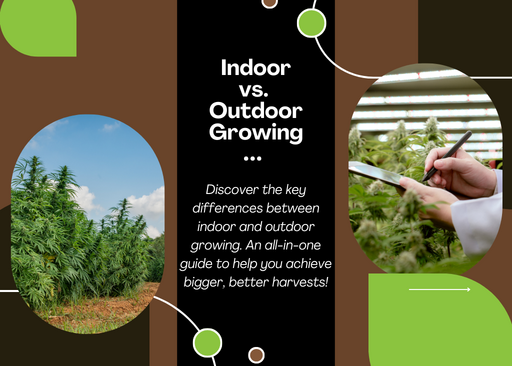
Indoor vs. Outdoor ~ Which Do You Choose?
Growing Cannabis is an amazing way to appreciate the journey from seed to harvest, but before you settle on an indoor setup or an outdoor plot, it’s important to understand the nuances that can make or break your garden. From local regulations to space considerations for both craft growers and commercial operations, this guide will help you navigate all the ins and outs of indoor vs outdoor cultivation.
Kick Off Your Adventure
Before diving into any growing project, be sure to familiarize yourself with the laws in your region. Rules vary widely, and there’s nothing worse than having to shut down a budding operation because of overlooked restrictions. Whether you’re a hobbyist working in a tiny apartment closet or a commercial enterprise eyeing a warehouse or multi-acre farm, ensuring compliance is crucial.
Both indoor and outdoor methods offer unique perks. Maybe you’re drawn to the idea of controlling every last variable in a specialized indoor space. Or perhaps the allure of fresh air and natural sunlight for your garden is too enticing to resist. Wherever you land, this breakdown will help you decide which approach works best for your goals, budget, and growing environment.
Exploring Cultivation Methods
Indoor Growing
An indoor setup gives you the power to manage everything from temperature to humidity. Over the years, improved technology (like high-efficiency LED fixtures and automated climate systems) has taken indoor projects from home-brew closet grows to large-scale commercial facilities.
- Ideal for: Areas with harsh climates, hobbyists with limited outdoor space, or businesses seeking total control over each growth cycle.
- Small-Scale Twist: Many small craft operations lean toward indoor systems because they can fine-tune conditions for each plant, achieving consistent results in tight quarters.
- Large-Scale Variation: Commercial ventures might section off rooms for different strains, each with a tailored environment, maximizing overall yield.
Outdoor Growing
Outdoor gardens embrace the free elements of sunshine, wind, and rain. Historically, this has been the go-to method around the world, requiring minimal equipment and offering bountiful yields—assuming the weather cooperates.
- Ideal for: Mild climates, homeowners with backyard space, and anyone with farmland who wants a natural approach.
- Small-Scale Twist: Even a few well-tended plants in raised beds or containers can flourish without the cost of high-tech gear.
- Large-Scale Variation: Commercial outdoor cultivation can span acres, but watch out for region-specific regulations and the unpredictable hand of Mother Nature.
Pros and Cons (Keep It Real)
The Indoor Edge
Upsides
- Year-Round Harvests: Control your lighting and climate, so you’re not at the mercy of the seasons.
- Fewer Pest Issues: A sealed space keeps most critters out, simplifying pest management.
- Privacy & Discretion: Perfect if you want to keep a low profile or adhere to local requirements about visibility.
- Scalable: Start small with a simple tent or go big with multiple rooms—scalability is easy.
Trade-Offs
- High Setup Costs: Lighting, ventilation, and other gear can strain the wallet (and spike the electric bill).
- Technical Know-How: Balancing environmental factors demands a bit of research and trial and error.
- Limited Space: If your indoor area is tiny, you’ll need creative training techniques to maximize yield.
The Great Outdoors
Upsides
- Budget-Friendly: Sunlight is free, and so is fresh air. Plus, no expensive ventilation systems needed.
- Bigger Plants: Under optimal conditions, outdoor specimens can get impressively large, offering hefty yields.
- Eco-Conscious: By going natural, you can reduce your carbon footprint and energy usage.
- Space for Expansion: If you’ve got the land, you can scale up without worrying about a ceiling.
Trade-Offs
- Climate Concerns: Extreme heat, cold snaps, storms—one bad season can stunt or destroy your harvest.
- Pests & Wildlife: Rabbits, deer, insects, and more may want a piece of your precious greenery.
- Privacy: Depending on where you live, nosy neighbors or passersby might spot your plants if you’re not careful.
- Legal Restrictions: Some areas have stringent laws about outdoor visibility—be sure to check local rules.
Key Points to Ponder
Local Regulations
- Double-check your state and municipal laws before you plant a single seed. Some places restrict the number of plants or the type of setup you can have.
- Commercial growers may require licensing, proper zoning, and inspection protocols. For craft growers, local rules can vary widely. Make sure you know what’s allowed.
Climate & Geography
- Indoor: Great for frigid winters, scorching summers, or unpredictable weather.
- Outdoor: Ideal in regions with moderate temperatures and predictable rainy seasons.
Space & Scale
- Small Craft: A spare bedroom, closet, or greenhouse might suffice for boutique production.
- Larger Enterprises: Warehouse grows or farmland expansions come with bigger yields but also steeper operating costs.
Budget & Resources
- Indoor: Factor in equipment for lighting, ventilation, and climate control.
- Outdoor: You’ll spend less on gear but could face extra costs for fencing, irrigation, or pest deterrents.
Desired Outcome
- Personal Use: Focus on quality and experimentation—test out new strains and techniques.
- Commercial Ventures: Efficiency and consistency become top priority to maximize profits.
Strategic Tips (For the Win)
Optimize Your Indoor Garden
- Pick the Right Lights: LED fixtures balance efficiency with strong output and can be adjusted to your plant’s growth stage.
- Control the Climate: Monitor temperature, humidity, and airflow to prevent mold or heat stress. Automation systems can make life easier.
- Use Smart Training Methods: Topping, low-stress training (LST), and scrogging can help you squeeze top yields out of tight spaces.
Level Up Your Outdoor Plot
- Plan for Weather: Keep protective coverings like hoop houses or simple tarps handy for sudden storms.
- Soil and Nutrients: Enrich the earth with compost or worm castings. Regular testing ensures you maintain the right pH.
- Defense Against Pests: Companion planting (marigolds, basil, etc.) can deter harmful insects. Fencing or netting may be needed in areas with deer or rabbits.
Wrapping It All Up
Whether you’re a small-scale hobbyist who wants a tiny but mighty setup or a commercial grower eyeing a full-blown operation, the indoor vs outdoor debate doesn’t have a one-size-fits-all answer. It boils down to your local climate, regional regulations, available resources, and personal style. Indoor environments put you in the driver’s seat with year-round control, while outdoor gardens rely on nature’s generosity for bigger, more cost-effective yields.
If you’re unsure, why not try both? A small test run indoors can give you insight into cultivating with total control, while planting a few seeds outdoors helps you harness the free power of sunlight. Above all, remember to keep up with local laws and permit requirements. There’s nothing like enjoying the fruits of your labor—especially when it’s done with confidence and compliance.
No posts found
Write a review
